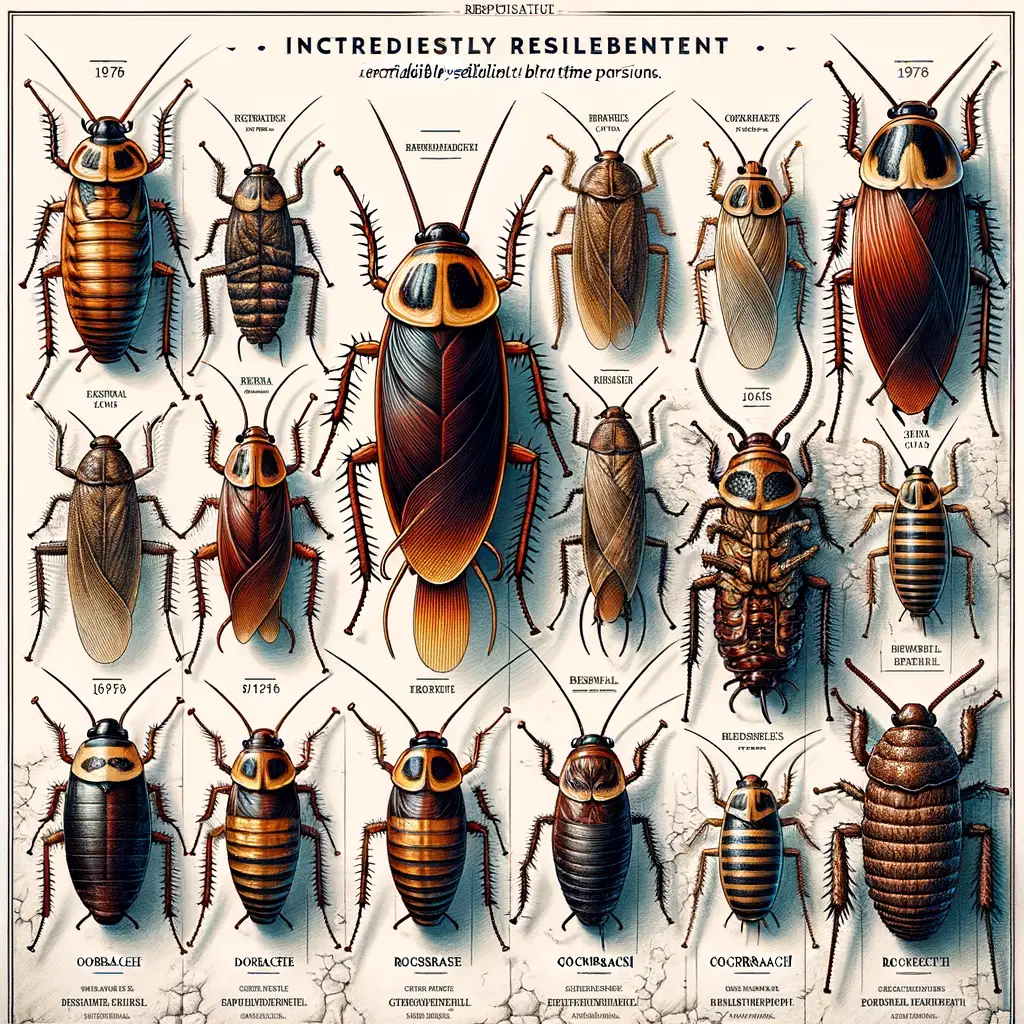
Introduction to Cockroaches: Ancient Insects
Cockroaches are some of the oldest insects on our planet. These fascinating creatures have been around for millions of years, and they have a lot to teach us about the world’s history and the evolution of life on Earth. In this section, we will explore the different species of cockroaches, their role in insect history, and why studying these ancient insects is so important.
- Overview of Cockroach Species
- Role of Cockroaches in Insect History
- Importance of Studying Ancient World Insects
There are about 4,600 species of cockroaches, but only about 30 species are associated with human habitats and are considered pests. The most common species include the German cockroach, the American cockroach, the brown-banded cockroach, and the Oriental cockroach. Each species has its unique characteristics and behaviors. For example, the German cockroach is known for its rapid reproduction, while the American cockroach is the largest species that infests homes. Learn more about cockroach species here.
Cockroaches have a significant role in insect history. They have been around since the Carboniferous period, which was over 300 million years ago. This makes them one of the oldest groups of insects, indicating that they have a high survival rate and adaptability. Fossil evidence shows that ancient cockroaches were very similar to modern ones, suggesting that they have not changed much over millions of years. This resilience and adaptability make them an interesting subject of study for scientists.
Studying ancient insects like cockroaches can provide valuable insights into the Earth’s history. They can tell us about the climate and environment of the past, and how these factors have influenced the evolution of life on Earth. Moreover, understanding the survival strategies of cockroaches can help us develop better pest control methods and potentially discover new materials and substances for medical and technological applications. Learn more about the study of ancient insects here.
The Evolution of Cockroaches
Let’s delve into the fascinating world of cockroaches and their evolution. These insects have been around for millions of years, and their survival is a testament to their adaptability and resilience.
Cockroach Survival: Adapting Through Time
How have cockroaches managed to survive for so long? Let’s explore this question by looking at their survival strategies and the key adaptations they’ve made over time.
- Surviving insects: How cockroaches have endured
- Cockroach adaptations: Key changes over time
Cockroaches are among the oldest surviving insect species on the planet. They first appeared during the Carboniferous period, over 320 million years ago, which is about 70 million years before the first dinosaurs. Their survival can be attributed to their incredible adaptability. Cockroaches can survive in a wide range of environments, from the tropics to the Arctic, and they can feed on almost anything, including paper, clothing, and dead insects. This adaptability has allowed them to survive changes in climate, habitat, and food sources over millions of years. [source]
Over time, cockroaches have developed several key adaptations that have helped them survive. For example, they have a highly flexible diet, which allows them to eat almost anything. They also have a hard exoskeleton that provides protection against predators and harsh environments. Additionally, cockroaches have developed the ability to reproduce quickly, with some species producing up to 30,000 offspring in a year. Finally, they have evolved to become nocturnal, which helps them avoid predators. These adaptations have allowed cockroaches to survive and thrive in a wide range of environments and conditions. [source]
Understanding the evolution of cockroaches provides us with a fascinating glimpse into the history of life on Earth. These resilient insects have survived for millions of years, adapting and evolving to meet the challenges of a changing world. Their story is a testament to the power of adaptability and resilience.
Cockroaches in History: A Prehistoric Perspective
When we think of cockroaches, we often associate them with our modern-day environments. However, these insects have a long and fascinating history that predates human existence. Let’s take a journey back in time to understand the first appearance of cockroaches in the fossil record and the changes in cockroach species over time.
- First appearance of cockroaches in the fossil record
- Changes in cockroach species over time
Cockroaches are among the oldest insects on our planet. The first appearance of cockroaches in the fossil record dates back to the Carboniferous period, approximately 320 million years ago. These ancient cockroaches, known as Archimylacris, were quite different from the ones we see today. They had long, slender bodies and were likely to be active during the day, unlike most modern cockroaches that are nocturnal.
Over millions of years, cockroaches have evolved and diversified into over 4,600 species that we know of today. The changes in cockroach species over time are a testament to their adaptability and resilience. For instance, the German cockroach, one of the most common species found in human habitats, has developed resistance to many pesticides. This adaptability has allowed cockroaches to survive and thrive in a variety of environments, from tropical forests to urban apartments.
In conclusion, the history of cockroaches is a fascinating journey through time. From their first appearance in the fossil record to the changes in species over millions of years, these insects have proven their resilience and adaptability. As we continue to study cockroaches, we gain valuable insights into their evolution and survival strategies, which can help us better understand and manage these ancient insects.
Understanding Cockroach Lifespan
One of the most fascinating aspects of cockroaches is their lifespan. These resilient creatures have been around for millions of years, and their longevity is a testament to their adaptability and survival skills. In this section, we will delve into the lifespan of cockroaches, dispel common misconceptions, and explore the factors that influence their longevity.
The Longevity of Cockroaches: Facts and Misconceptions
There are many misconceptions about the lifespan of cockroaches, often fueled by their reputation as hardy survivors. Let’s set the record straight and explore the true facts about cockroach longevity.
- Average lifespan of common cockroach species
- Factors influencing cockroach lifespan
The lifespan of a cockroach varies depending on the species. The German cockroach (Blattella germanica), one of the most common species, has a lifespan of about 6 to 9 months. The American cockroach (Periplaneta americana), on the other hand, can live for up to 2 years. It’s important to note that these are averages, and individual lifespans can vary.
Several factors can influence the lifespan of a cockroach. These include environmental conditions, access to food and water, and exposure to predators or pesticides. Cockroaches that live in optimal conditions with plenty of food and water, and minimal exposure to threats, can live longer than those in harsher environments.
In conclusion, while cockroaches are indeed resilient creatures, their lifespan is not infinite. They are subject to the same life cycle stages as other insects: egg, nymph, and adult. Understanding the lifespan of cockroaches can provide valuable insights into their biology and behavior, and can help in developing effective pest control strategies.
Case Study: Cockroaches and Their Environment
One of the most fascinating aspects of cockroaches is their ability to adapt and thrive in a variety of environments. This section delves into how cockroaches have evolved to survive in human environments and the impact of human activity on their evolution.
Adapting to Human Environments
Cockroaches are not just survivors; they are adaptors. They have shown an incredible ability to adjust to new environments, particularly urban ones. Let’s explore this in more detail.
- How cockroaches have adapted to urban environments
- Impact of human activity on cockroach evolution
Cockroaches have been around for millions of years, surviving through drastic changes in climate and environment. Their real success, however, lies in their ability to adapt to urban environments. Cockroaches have evolved to become nocturnal, hiding during the day in dark, warm places like cracks and crevices, and emerging at night to feed. This behavior helps them avoid human interaction and increases their chances of survival.
Human activity has significantly influenced the evolution of cockroaches. The use of pesticides, for instance, has led to the development of pesticide-resistant cockroaches. Additionally, the abundance of food and shelter in human habitats has allowed cockroaches to reproduce rapidly, leading to larger populations. This rapid reproduction, coupled with their ability to adapt to pesticides, makes controlling their populations a challenging task.
In conclusion, cockroaches are a testament to the power of adaptation. Their ability to thrive in human environments demonstrates their resilience and highlights the impact of human activity on their evolution.
Surviving in Extreme Conditions
When it comes to survival, cockroaches are one of the most resilient creatures on the planet. They can thrive in some of the harshest environments imaginable. Let’s explore some examples and the adaptations that enable their survival in extreme conditions.
- Examples of Cockroaches Living in Harsh Environments
- Adaptations that Enable Survival in Extreme Conditions
Cockroaches are found all over the world, from the icy landscapes of the Arctic to the scorching deserts of the Sahara. For instance, the Madagascar hissing cockroach (Gromphadorhina portentosa) survives in the dense, humid forests of Madagascar, while the desert cockroach (Arenivaga investigata) thrives in the arid conditions of the American Southwest.
Perhaps the most extreme example is the German cockroach (Blattella germanica), which has adapted to live alongside humans in urban environments. These cockroaches can survive in the most inhospitable conditions, including high radiation levels and a lack of food and water.
Cockroaches have developed a number of unique adaptations that allow them to survive in extreme conditions. One of the key adaptations is their ability to go without food and water for extended periods. Some species can survive for up to a month without food and two weeks without water.
Another important adaptation is their exoskeleton. The tough, flexible exoskeleton protects them from physical harm and helps to prevent water loss in dry environments. Furthermore, their small size and flat bodies allow them to hide in narrow cracks and crevices, protecting them from predators and harsh environmental conditions.
Finally, cockroaches are known for their rapid reproduction rate. This allows populations to recover quickly, even after significant losses, ensuring their survival in challenging environments.
In conclusion, the survival of cockroaches in extreme conditions is a testament to their remarkable adaptability and resilience. These ancient insects have evolved over millions of years to become one of the most successful species on our planet.
Conclusion: The Resilience of Cockroaches
As we conclude our journey into the world of cockroaches, it is clear that these ancient insects are a testament to resilience and survival. Their evolution and adaptability have allowed them to thrive in diverse environments and withstand significant changes in the world around them.
- Key takeaways about cockroach survival and evolution
- The future of cockroaches in a changing world
Firstly, cockroaches are among the oldest insects on the planet, with a history dating back over 300 million years. Their evolutionary journey has equipped them with remarkable survival skills. They can live without food for a month, survive without air for up to 40 minutes, and even withstand radiation levels that would be lethal to humans. Wikipedia provides a comprehensive overview of their survival capabilities.
Looking ahead, the resilience of cockroaches suggests that they will continue to survive and adapt in a rapidly changing world. Climate change, urbanization, and other environmental shifts may pose challenges, but the cockroach’s ability to adapt and thrive in diverse conditions indicates a promising future for these insects. As we continue to study and understand them, we may even discover more about their remarkable abilities and the secrets of their survival.
In conclusion, cockroaches are a fascinating study of survival and resilience. Their ability to adapt and thrive in a wide range of conditions is a testament to their evolutionary success. As we face an uncertain future, there is much we can learn from these resilient creatures about survival and adaptation.
